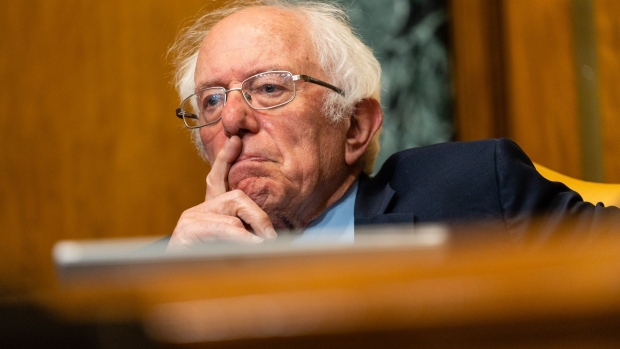Aug 31, 2022
Student-Loan Relief Stirs Democratic Dreams of Young-Voter Boost
, Bloomberg News

(Bloomberg) -- Democrats have two months to determine whether President Joe Biden’s student-debt relief plan is enough to repair fractured relations with young voters the party needs in an election with control of Congress at stake.
Biden has been under intense pressure from voters under 30 to enact a more progressive agenda since they helped him reach the White House in 2020. He carried about 60% of voters between 18-and-29 years old, but his inability to keep some of the bold promises he made during a campaign set against the backdrop of a national conversation on race and equality caused them to sour on his presidency.
The president’s unpopularity presents a big challenge for Democrats before November, considering young Americans voted at record levels in the 2020 election as well as the 2018 midterms. While the president’s party typically loses seats in elections held during their first terms, polls show Democrats with momentum that could temper losses in the House and allow them to possibly expand their thin majority in the US Senate.
Yet they will need every part of the electorate that they cobbled together in 2020 to show up -- including the younger bloc of voters. Biden’s fulfillment of a campaign pledge to relieve debt can be interpreted as a mending of fences in his relationship with that constituency.
There are early signs for optimism among Democrats.
A CBS News/YouGov poll conducted between Aug. 24 and Aug. 26, covering the period that Biden made the student loan relief announcement, showed his approval rating at 59% with voters under 30 years old, a 10-point surge from July. Biden’s approval rating among that demographic was 70% in February 2021, but it plunged to 42% in January 2022.
Biden’s overall approval rating inched up to 45% from 42% in July, the poll showed.
Jalen Miller, a student at the University at Albany in New York and national president of College Democrats of America, said his campus was buzzing in the aftermath of Biden’s Aug. 24 announcement.
“This was the topic of conversation all of yesterday and pretty much today. I’m seeing a lot more people care about it on campus. I spoke to at least five people yesterday, talking to me about this issue, asking me about it, and how it’s going to affect my vote,” Miller said in an Aug. 25 telephone interview.
Biden strung together a series of August victories, including legislation on veterans’ health, bipartisan passage of a bill to increase semiconductor chip manufacturing and a measure to address climate change and lower prescription drug costs.
That streak was capped by the student loans order.
“If we elect more Democrats to the Senate and keep the House Democratic, imagine the possibilities,” Biden said in an Aug. 28 tweet, an implicit plea to his base.
The 2020 presidential election occurred alongside the most substantive national conversation on race since the 1960s. In May of that year, a Minneapolis police officer murdered George Floyd, an unarmed Black man, touching off protests across the country, but also introspective dialog on racism and systemic inequalities, including wealth disparities.
Cornell Belcher, a Democratic pollster who worked on Barack Obama‘s presidential campaign, said Biden’s announcement delivers on a campaign promise made to a key voting bloc.
“One of the groups that historically are the most problematic for Democrats in the midterm election are younger voters who we consistently see in most midterms drop off significantly,” Belcher said. “This is really good politics, because it is in fact promises being kept to these young voters who were a pillar of his coalition.”
Intra-party fighting and opposition from Republicans helped to whittle down a more ambitious climate and social safety net plan that Biden had championed. Likewise, his efforts to enact police and voting rights reform also stalled in Congress.
Miller said that while Biden’s move on student loans promises to ignite younger voters, there’s more yet to be done.
“This is a great step forward to get the youth vote invigorated for Biden in the midterms and 2024. But I do think there’s a step to be had or things to be done. I don’t want this to be the end of the student debt conversation. I still believe in all student debt cancellation,” he said.
At the same time, some moderate Democrats, including Representative Tim Ryan, who’s running for a Senate seat in Ohio, have criticized the plan over its costs.
If Biden’s sweeping executive order survives potential court challenges, the plan will cancel $10,000 of debt for borrowers earning less than $125,000 and as much as $20,000 for Pell grant recipients.
There’s signs that the electorate is split on whether Biden landed on the right figures for relief.
In a recent Emerson poll, voters were asked if the student loan relief program is too much, not enough, or just right. There was a stark age divide. Forty-three percent of voters between the ages of 18-34 said it’s not enough action. A plurality of those over 50 said Biden’s plan was “too much.”
Senator Bernie Sanders, a Vermont Independent who caucuses with Democrats, called the plan “an important step forward” but that more needs to be done at a time of massive wealth and income inequality.
Almost immediately after Biden’s announcement, Republicans swatted down the plan, with Republican Senate minority leader Mitch McConnell calling it “a slap in the face” to those who paid their debt.
“I still believe that it’s more than ever that has been done for students, their families and their futures,” said Paul Brathwaite, chief strategist at Federal Street Strategies, in response to progressives who believe $10,000 might not be enough for borrowers.
©2022 Bloomberg L.P.





